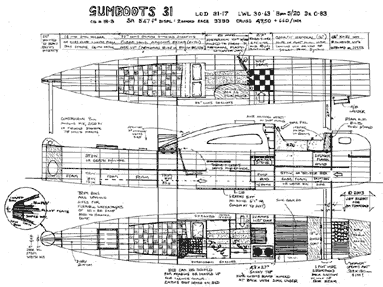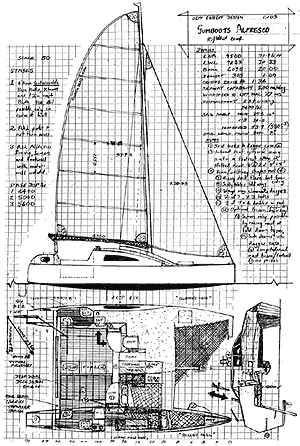Plans are afoot to commence building the fast cruising, open
decked 31 foot Catamaran Gumboots in Australia in 2005. This
sis the one from which building plans will be derived. Hulls
are around 31 x 5 feet.
The triangle bottom shape in the drawing below (with 10.5 WL
length to WL beam) may never be developed to build plan stage
despite my belief that it will outperform any boat hitherto
designed upwind. Weight is thrown onto the lee chines, which
are angled 3 degrees upwind. These hulls automatically fight
lee drift. The triangle footprint makes builders nervous for
the wrong reasons, the boat has been shaped & balanced not
to bow plunge, but the inevitable losses are in the exit waterflow
which is not as clean as a conventional hull.
The new bottom is still a dory, but faster at better than 12
to one. It makes the main cabins bigger and the aft Head and
Navigation cabins are a little longer and narrower in footspace
only. You can still seat 4 in opposing pairs for cards, but
two of the seats are fold downs and the big comfy 2 seater with
room to stretch legs right out is the go.

click to enlarge
Transportable Version with New Bottom
Interest in a version of Gumboots that could be
transported in a container led to a concept redesign, involving
a more conventional bottom shape to enable a narrower overall
hull. Take away the 5-foot beam & the accoms are a problem,
eased by redesigning the bottom.
Some containers are as narrow as 91 inches. The
space can be eased by putting the hulls nose past nose, with
centrelines offset a foot over the container length. With packing
they cross 12 feet aft of the bow where the hull is 94.3 percent
of its beam.
The hulls I’ve sketched here are 4 footers
and will go in a container 91 inches or 2300mm wide. Just. No
room at all left. Unless one can find a bigger container for
sure the hulls should be on 3.75ft frames, or else one may face
paying for two.
A packed up 28-footer crosses at 83 percent of
its beam and so can be much wider.
The safe options for guaranteeing container ability:
The 31 hulls packed simply cross too close to
their point of maximum beam to get good hull width. Put up with
it or double the work with deck level accommodations.
In many ways I’ve drawn the wrong boat here,
a 28 with wider hull beam would be the best way to go. Not as
fast as the 31, the 28 may as well make the sole wider and get
very comfortable. It could thus be comfy enough without deck
pods. The missing meter would come out ford of the crash bulkhead,
the cockpits and the dining table, a bit everywhere and you
wouldn’t miss it much except in miles made good.
The “Galley” hull has an athwartships
galley with the corner of the bench stepped on to get below.
The sink is off to one side; its structure supports the dagger
case or outboard dagger rungs at bridgedeck level. A stronger
method would be an extra box beam from dagger case to case.
The narrower hull has angles which means very
comfortable fold up seats can be created facing outboard with
an athwartships seat of 30 inch width in which 2 might jam if
they were in love. Otherwise it’s a great armchair. You
wont be playing bridge without the 5-foot wide hull. The ford
berth is 84 x 34“ too tight for two.
The “Owner’s Stateroom” hull
would have the berth in the wider part of the hull and high,
losing a bit of potential cabin space to get about a 43 inch
wide double in the 28 foot version, and a 39 incher in the 31.
Still leaving enough room for a thru shower entry, and good
dressing space. The drawing is in one-foot squares, print it
and have a scribble. There’s room for a deck accessed
single forrd. Some may prefer to raise the cockpit and put a
single berth each end of a large open space.
Over the 31 x 5 hulls in a previous article, you
lose nothing but the width to stretch. Gumboots is a small yacht,
really best for 3 on a trip, but very safe offshore with thru
bridgedeck draining, high clearance, deep cockpits and extreme
stability.
I’m not saying it’s easy to build.
I am saying it is possible for a human to do without wrecking
their life, where most offshore designs are not.
If you wish to move your Gumboots, it must be
built in its simplest form so it’s demountable. You could
build independent deck pods containing double berths that lash
on the deck slats, and take them with you.
Gumboots Alfresco
A homebuilder’s Dreamboat, buildable from
the bare and simple transportable model. You might do this after
sailing the basic Gumboots for many years, or accidentally having
a family! I know it’s pretty basic, but to my way of thinking
it’s a massive job and this is why the boat can be built
in stages. Note that this could be done to pretty well any cat
with 20 feet of beam. If she were 28-footer, the bridgedeck
eatery or a berth would go, as you couldn’t carry the
beam comfortably.
Having transported Gumboots where you want to
be, you will probably want more room. Gumboots Alfresco is a
two-stage idea involving putting doubles berths up on the bridgedeck.

click to enlarge
The mast would be raised a foot as shown to cover
the pod, but if you added the screen it would go up a further
18 inches. The windspeed to raise a hull at 29 knots on the
beam is so high that this simply isn’t an issue –
the beam of the cat makes it extraordinarily stable and she’s
a very swift reacher as a result. The screen covers a really
nice central dining area that seats five, which is about the
most you’d take on the boat. Inside there is space to
seat 4 or 5 around a table for dining or a game of cards, but
both outward facing seats and table fold down in halves with
a cutout bulkhead, a necessary evil, between them. You wouldn’t
sit in for a long period, as unlike the other larger seats you
can’t stretch your legs out. The aft armchair provides
bracing for the cook at stove, sink or chopping board.
On deck there is a substantial centre beam to
build as a footwell; it could also take motor and fuel. If you
were sure to go this way you would already have built it in
the original.
The biggest plus is the spray protection afforded
the bridgedeck on this fast boat. Others are the apparent room
inside, giving a massive increase in resale value.
The biggest minus is your boat is no longer demountable,
and that this is a massive job, taking nearly as long as the
original build.
How fast does it go?
This is as useful a question as “What colours
does it come in? But I’ll try.
In a swift cat you invariably wind up on a reach
as you pull the apparent wind onto your beam. On a good day,
reaching in the basic 2 ton no-frills clear decked 31 foot Gumboots
with the sail plan drawn, you would be cruising along happily
with a 21 knot wind off the beam and the full sail plan up,
alert for gusts, and your sails developing 25 horsepower. You
have a power to weight ratio of 200 lbs per HP and you would
in a conventional mono be travelling at speed to length of 1.85
if the hull could manage it. These hulls can not only manage
that, but also have a fineness factor on their side, which will
boost the S/L to 2.
I’d expect the boat to be cruising calmly
at 11 knots.
The top end is fairly wide open and depends on
skill, nerves and sea state. If you have a strong steady 25-knot
wind and flat sea 15 knots plus is possible. Many claimed 20-knot
boats will overturn before Gumboots, which, sailed correctly,
will sideslip if she lifts a hull, and won’t capsize at
all. By this I mean if you are trying to reach in gusty, lumpy
conditions you should pull up the lee dagger board and point
a little more upwind. If a hull flicks up you will simply sideslip
and drop back in.
Heavier Gumboots will be slower in light airs
and relatively faster than a stripped light version in heavy
going.
Richard Boehmer’s respected “Base
Speed” formula predicts seaway passagemaking in 24 hours
as follows:
Immersion is around 660 lb an inch and you can
take a ton of junk to sea.
Literally. But it will cost you 15 percent, 30
nm per day, or 1.25 knots.
Final Comments
The one to be built, Jim Townsend’s, is
the best of Gumboots as it follows the creed of absolute simplicity.
It will be slightly modified to a more conventional bottom giving
an improved aft run, a bit more speed and improved accommodation
space. No need of bridgedeck accommodation. The new bottom allows
the main beam to move forward up to 2 feet – I tried this
to its full extreme in the drawing above which has slightly
longer cockpits as a result. The final position will be determined
by a weights study but will probably be at 10 feet to the old
eleven (and the above nine). Moving this beam gives a bigger
cabin and more overall space especially over the berths. With
the new bottom and the five-foot hull beam they can be 42 inches
wide not 39, sited right where designed below. The five-foot
hull beam does allow better damping and the boat will be plenty
fast, and incredibly stable, able to run with full sail in a
force five. This is largely due to the low tack and wide beam,
and roachy fully battened main. I’ve just designed an
almost identical sail for a 30 foot Simpson Little Bear, which
will be a good indicator. With Little Bear at 4 tons, the same
sail will certainly move this 2-ton ship, which is wider and
lower in CE, and will handle it with ease but very speedy results.
The main drawn this time around is both slightly bigger and
slightly lower in centre of effort.
You wont need any more than these two sails and a storm jib.
The main beam is the hardest part of the build
in the demountable form. Were the boat not demountable there
would be much merit in simply building a sweep of accommodation
across the boat, boxing this monocoque structure front and rear
into infra-beams.
Of course this still has to hold up the mast,
meaning more infrastructure.
We will see what happens when Jim, myself and
a few other champing at the bit Gumboots builders give the boat
our full attention next year.
Jeff Gilbert
- 2004

